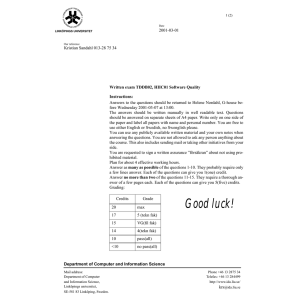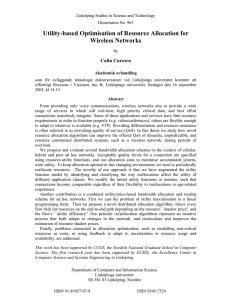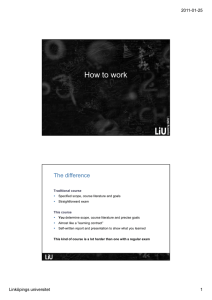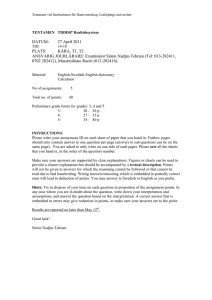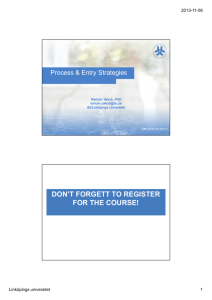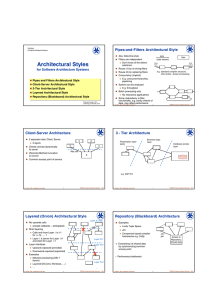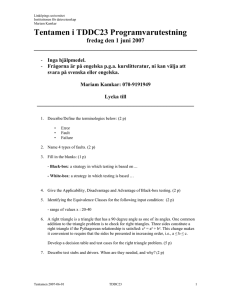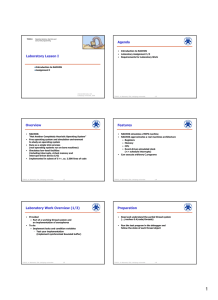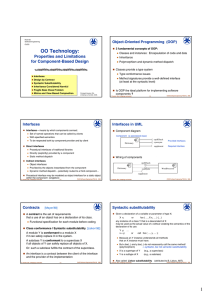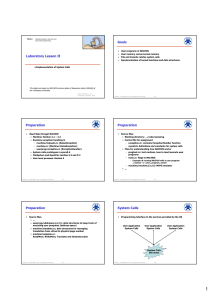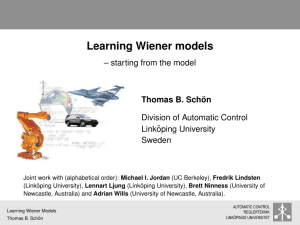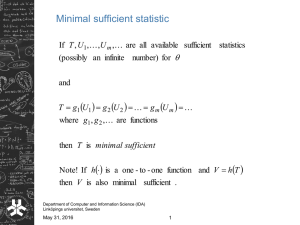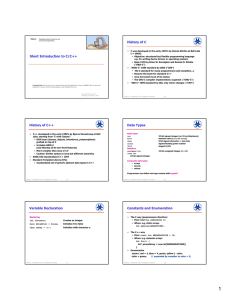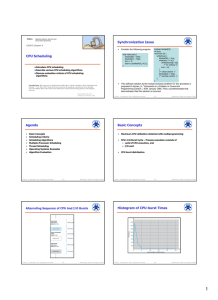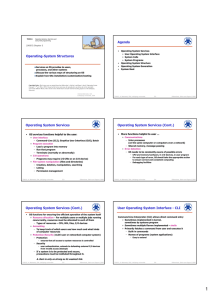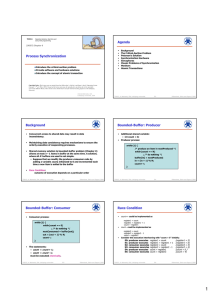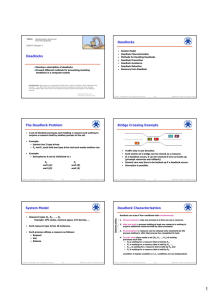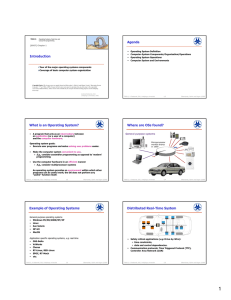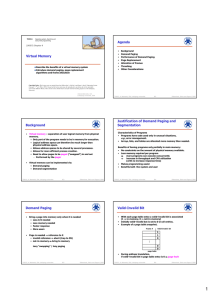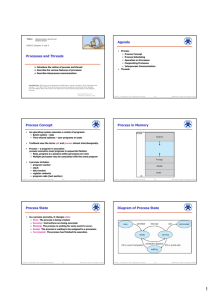Requirements evaluation Outline Why do we do this? Types of inconsistency
advertisement
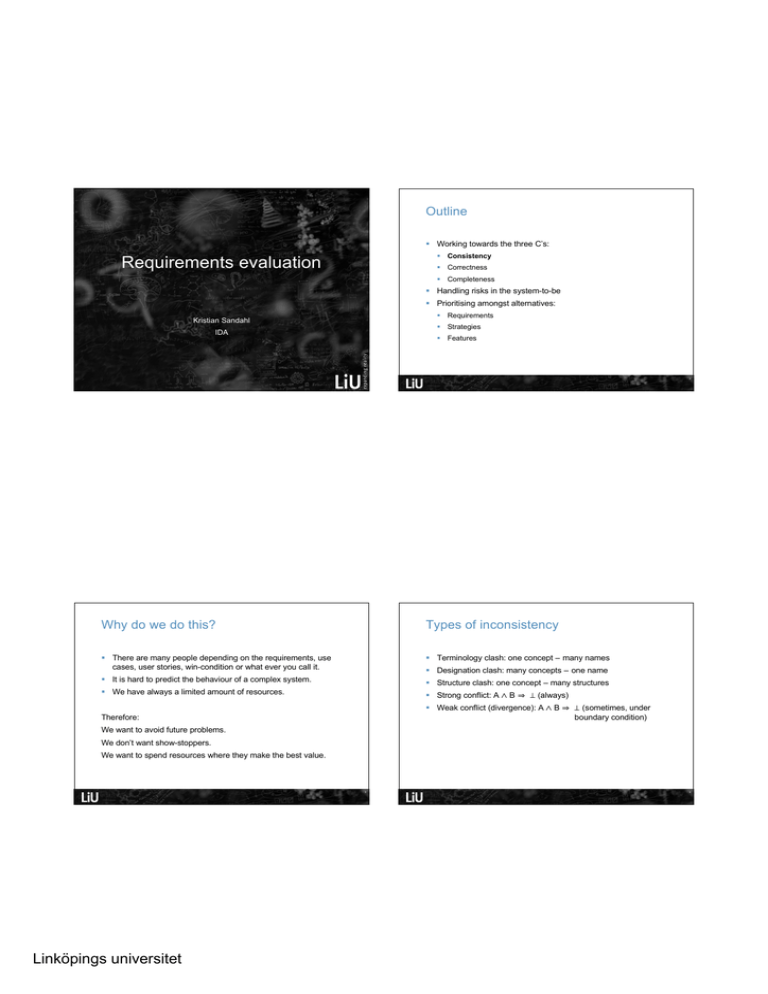
Outline Working towards the three C’s: Consistency Requirements evaluation Correctness Completeness Handling risks in the system-to-be Prioritising amongst alternatives: Requirements Kristian Sandahl Strategies IDA Features 2 Why do we do this? Types of inconsistency There are many people depending on the requirements, use cases, user stories, win-condition or what ever you call it. Terminology clash: one concept – many names It is hard to predict the behaviour of a complex system. Structure clash: one concept – many structures We have always a limited amount of resources. Strong conflict: A Designation clash: many concepts – one name B ⊥ (always) Weak conflict (divergence): A Therefore: B ⊥ (sometimes, under boundary condition) We want to avoid future problems. We don’t want show-stoppers. We want to spend resources where they make the best value. 3 Linköpings universitet 4 Terminology clash - dead parrot Detecting and identifying conflicts Mr. Praline: Reviewing requirements documents and models: Peer-review 'E's not pinin'! 'E's passed on! This parrot is no more! He has ceased to be! 'E's expired and gone to meet 'is maker! 'E's a stiff! Bereft of life, 'e rests in peace! If you hadn't nailed 'im to the perch 'e'd be pushing up the daisies! 'Is metabolic processes are now 'istory! 'E's off the twig! 'E's kicked the bucket, 'e's shuffled off 'is mortal coil, run down the curtain and joined the bleedin' choir invisibile!! THIS IS AN EX-PARROT!! Structured walk-through Inspection Cross-referencing requirements relations Heuristic detection Natural language processing techniques Formal techniques 5 Inspection process 6 Cross-referencing Group: Initial: Check criteria Detection, or Plan Collection Overview Inspection record R1 R1 Preparation, or Detection Change R6 R6 R7 OK OK R5 Document & data handling R5 OK R4 Follow-up R4 OK OK R3 Exit: R3 OK R2 Data collection Individual: R2 OK OK OK Conflict OK OK OK OK R7 Oops! 7 Linköpings universitet 7 8 Heuristic detection Natural language processing techniques Iteratively obtain a taxonomy of conflict-prone requirement classes: ex: control algorithms, exception handling Uses NLP approach to determine: Perform classification during elicitation Analyze different classes Similarities between specifications, ex: market wishes – product plans Search for keywords, important variables, ex: “decreasing” Finding candidates for consistency checking Create checklists, ex: investigate initial states, check that all variables are used, Consolidation of requirements Similarities within a specification, ex: functional – non functional The goodness of approach is measured by Recall, % correct classification per known classification Precision % correct classification per all system classification Johan Natt och Dag: Managing Natural Language Requirements in LargeScale Software Development, PhD dissertation Lund, 2005, (ISRN LUTEDX/TETS–1070–SE+222P) 9 Case study, similarity between specifications, preprocessing Case study, similarity measure 11 Linköpings universitet 10 12 Case study, similarity threshold and recall Formal notations, Z example Book example on white-board 13 Handling inconsistencies 14 The NFR Framework Good Capacity for accounts Glossary – cheap and effective way of handling terminology Secure accounts Negotiations: Stakeholders’ win-condition Conflicting Non-functional requirements (NFRs) Use resolution tactics: Response time Space Avoid boundary conditions – provide parallel solutions - Restore conflicting statements – find satisfying sequences of use - Weaken conflicting statements – permit exceptions + + Drop lower-priority statements Specialise conflict source or target – fine-grained domain model Use stakeholders in elicitation for resolution Use authority Use uncompressed format 15 Linköpings universitet Use indexing Validity access against eligibility rules 16 18 Risk management, some terminology Hazard, Incident, Accident A risk is an uncertain factor whose occurrence may result in a loss of satisfaction of a corresponding objective. Hazard – System state or condition that may lead to an incident. A risk has a likelihood of occurrence, some authors use probability Incident – Potentially dangerous system behaviour If occurred, a risk has negative consequences Accident – Unplanned sequence of events that lead to human death, severe injury or big loss of resources Each consequence has a severity, some authors use impact Risks are handled with countermeasures Focus of the book: Product-related risks 17 Risk management process 18 Risk identification Risk checklists Missing functions Wrong assumptions Risk identification Risk assessment Risk control Hazards Vulnerabilities.... Software reviews Risk trees Scenarious Knowledge reuse Brainstorming 19 Linköpings universitet 20 Risk assessment Defect Detection Prevention (DDP) Impact matrix L(c) – likelihood of occurrence for consequence c 0 S(c) – severity of consequence c Assume risk r has a set of independent consequences Risk exposure Exp can be calculated as Exp(r ) = ! L(c) " S (c) c Some authors use Risk Magnitude Indicator with averaged S(c) per risk Some authors use Risk Criticality explicitly calculating risk as a weighted sum of different objective consequences 0.7 " (0.4 " 0.3 + 0.3 " 0 + 0.1" 0.3 + 0.2 " 0.1) ! 0.12 21 22 Risk control tactics (strategies) Finding countermeasures Avoid – Require failure-safe mechanisms What-if questions in elicitation Transfer – Buy components Simulate system or process Accept Prototyping Mitigate – Lower the likelihood of occurrence Define contingency plan – A “plan B” if the risk occurs Risk-Reduction Leverage (RRL) for risk r and countermeasure cm RRL(r , cm) = ( Exp(r ) ! Exp(r cm) / cost (cm) Exp( r|cm) is the new risk exposure given that cm is taken. 23 Linköpings universitet 24 Evaluating alternatives Weighted matrices Decisions are everywhere in requirements: Criteria Option1 Option2 Option3 Alternative combinations of sub-systems Convenience 0.3 0.5 0.9 ... Alternative system boundaries Reliability 0.6 0.9 0.3 ... Price 0.1 0.5 1.0 ... Total 1.0 0.74 0.55 ... Alternative conflict resolution methods Alternative countermeasures Weight Values can be based on judgement, statistics or both Alternative scheduling Alternative software acquisition opportunities totalScore(opt ) = ! ( Score(opt , crit ) " Weight (crit )) Alternative business strategies crit 25 26 AHP for requirements prioritisation AHP, calculating the relative priority Create hierarchies of comparable requirements that are on same abstraction level and in the same sub-system Let C be the comparison matrix, then w is a non-null so called eigenvector such that: Make pairwise comparisons on a 9 grade-scale and construct an AHP comparison matrix: Cw = !w λ is the eigenvalue Elements of w correspond to the relative priority for the requirements in the rows of C Always the inverse values 27 Linköpings universitet 28 AHP, approximating the calculation of the eigenvector Result from the book Normalise values per column, so 1 1/ 5 1/ 6 1/ 7 0.66 becomes 0.13 0.11 0.10 Next, sum the rows and divide by number of requirements, so 0.66 0.78 0.39 0.53 becomes 0.59 29 30 32 31 Linköpings universitet 31 32 Wait, a minute... What about correctness and completeness? What is the crucial prerequisite of the methods? 33 33 www.liu.se Linköpings universitet 34
